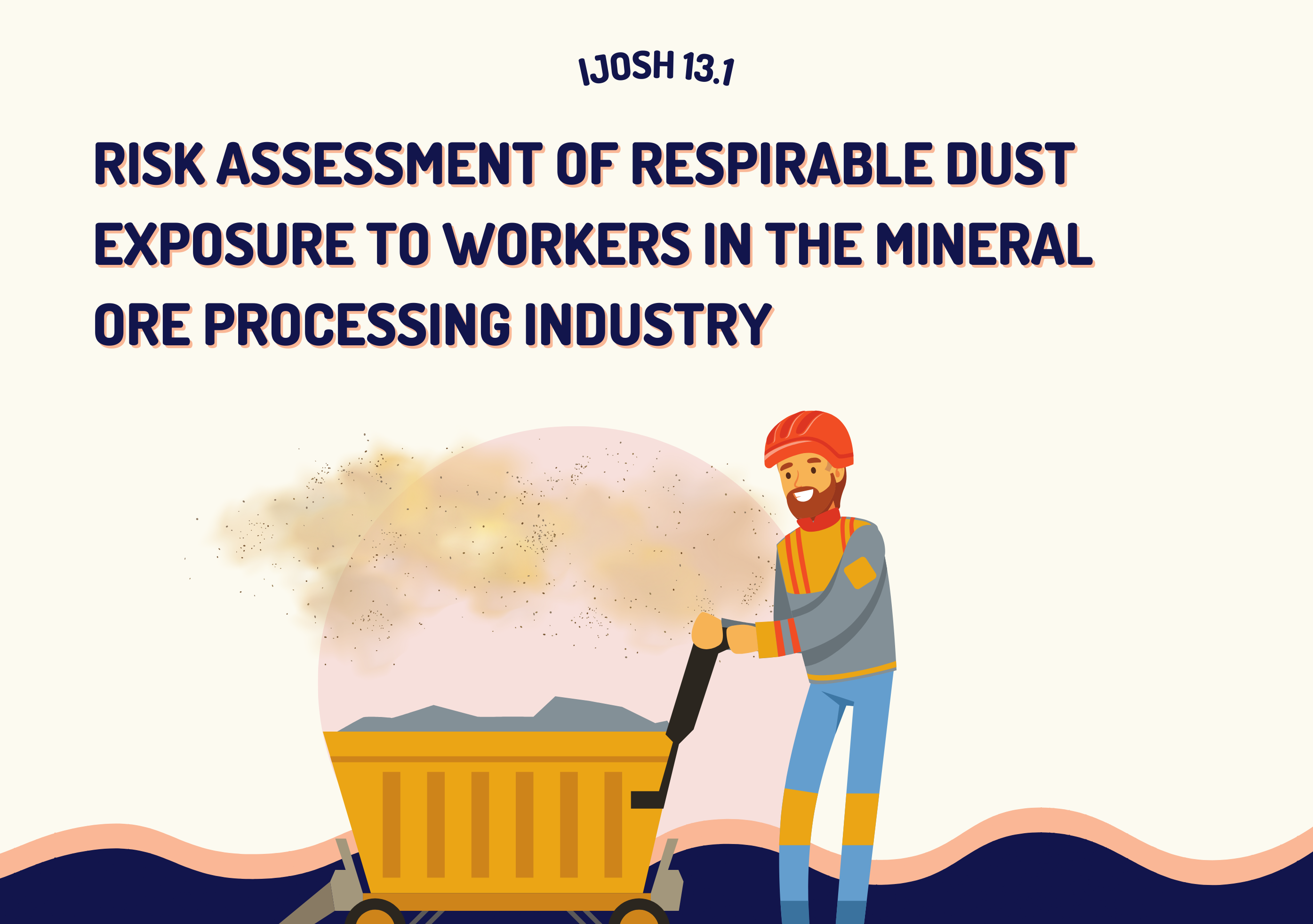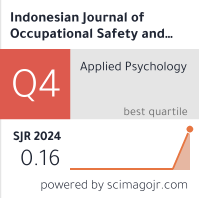Risk Assessment of Respirable Dust Exposure to Workers in the Mineral Ore Processing Industry

Downloads
Introduction: The mineral ore processing industry is a sector that can generate pollutants in the form of dust during the production, commonly known as respirable dust. This dust can enter the upper respiratory tract and lungs, thereby causing health problems to employees working in the mineral ore processing industry. This study aims to investigate health risks associated with exposure to dust in the mineral ore processing industry. Methods: Environmental Health Risk Analysis (EHRA) was used to assess dust exposure over the previous three years, following the NIOSH Manual of Analytical Methods (NMAM) 0600 for dust sampling measurement. Results: Seven locations with high dust emissions were considered for this study. The results of the respirable dust sampling showed that the concentrations in the previous three years ranged from 1,823 to 6,109 mg/m3, followed by a decrease in the following year to 0.049 to 2,715 mg/m3. Meanwhile, in the final year, the concentration of respirable dust ranged from 0.094 to 1.341 mg/m3. The calculated risk quotient (RQ) value for the previous three years remained below 1, indicating safety. Conclusion: Athough respirable dust was considered safe in the previous year, it is important to constantly control exposure due to continued high levels and the possibility of future increases
A'yun, I. Q. and Umaroh, R. (2023) ‘Polusi Udara dalam Ruangan dan Kondisi Kesehatan: Analisis Rumah Tangga Indonesia', Jurnal Ekonomi dan Pembangunan Indonesia, 22(1), pp. 16–26. doi: 10.21002/jepi.2022.02.
ACGIH (2023) 2023 TLVs and BEIs Based on the Documentation of the Threshold Limit Values for Chemical Substances and Physical Agents & Biological Exposure Indices. Ohio: American Conference of Governmental Industrial Hygienists.
Ahmed, S. et al. (2022) ‘Respiratory Symptoms, Spirometric, and Radiological Status of Stone-cutting Workers in Bangladesh: A Cross-sectional Study', Health Science Reports, 5(5), pp. 1–8. doi: 10.1002/hsr2.753.
Ajslev, J. Z. N. et al. (2022) ‘The Hierarchy of Controls as an Approach to Visualize the Impact of Occupational Safety and Health Coordination', International Journal of Environmental Research and Public Health, 19(5), pp. 1–14. doi: 10.3390/ijerph19052731.
Anes, N. I., Umboh, J. M. L. and Kawatu, P. A. T. (2015) ‘Faktor-Faktor Yang Berhubungan dengan Gangguan Fungsi Paru Pada Pekerja di PT.Tonasa Line Kota Bitung', JIKMU, 5(3), pp. 600–607.
Chaulya, S. K. et al. (2021) ‘Fugitive Dust Emission Control Study for a Developed Smart Dry Fog System', Journal of Environmental Management, 285, pp. 1–12. doi: 10.1016/j.jenvman.2021.112116.
Darwel, D. et al. (2022) ‘Descriptive Study of Respirable Dust Levels by Furniture Industry Workers in Nanggalo District, Padang City', SANITAS: Jurnal Teknologi dan Seni Kesehatan, 13(1), pp. 90–100.
Government of Indonesia (2021) Peraturan Pemerintah (PP) Nomor 22 Tahun 2021 tentang Penyelenggaraan Perlindungan dan Pengelolaan Lingkungan Hidup. Jakarta: Government of Indonesia.
Hardyanti, N., Huboyo, H. S. and Darmawan, M. (2021) ‘Rancang Bangun Green Belt Untuk Pengendalian Pencemaran Debu di Kawasan Industri Terboyo (Jalan Kaligawe)', Jurnal Ilmu Lingkungan, 19(3), pp. 681–689. doi: 10.14710/jil.19.3.681-689.
International Labour Organization (2019) Keselamatan dan Kesehatan Kerja di Tempat Kerja. Jakarta: International Labour Organization.
Lestari, M. et al. (2023) ‘Dust Exposure and Lung Function Disorders', Respiratory Science, 3(3), pp. 218–230. doi: 10.36497/respirsci.v3i3.80.
Li, H. et al. (2022) ‘Effect of the Installation Angle of Nozzle on the Atomizing Performance of Air-Assisted Spraying Dust Suppression Device', Atmosphere, 13(4), pp. 1–10. doi: 10.3390/atmos13040520.
Li, S. et al. (2021) ‘Review and Prospects of Surfactant-Enhanced Spray Dust Suppression: Mechanisms and Effectiveness', Process Safety and Environmental Protection, 154(6), pp. 410–424. doi: https://doi.org/10.1016/j.psep.2021.08.037.
Maleki, R. et al. (2020) ‘Monitoring BTEX Compounds and Asbestos Fibers in the Ambient Air of Tehran, Iran: Seasonal Variations, Spatial Distribution, Potential Sources, and Risk Assessment', International Journal of Environmental Analytical Chemistry, 102(16), pp. 4220–4237. doi: 10.1080/03067319.2020.1781836.
Mastrantonio, R. et al. (2021) ‘Exposure assessment to inhalable and respirable dust in the post ” earthquake construction sites in the city of l'Aquila', Journal of Occupational Health, 63(1), pp. 1–9. doi: 10.1002/1348-9585.12296.
National Institute for Occupational Safety and Health (2017) NIOSH Manual of Analytical Methods (NMAM). 5th Editio. Georgia: Centers for Disease Control and Prevention.
Nuhu, S. K. (2012) ‘Dust Emanating From the Mineral Processing and Mining Industry: Its Effect on Human and the Environment', Continental Journal Engineering Sciences, 7(1), pp. 36–43.
PT Freeport Indonesia (2023) Hasil Pengukuran Debu di Pabrik Pengolahan Bijih.
Roberts, J. and Wypych, P. (2019) ‘Research , Development and Application of Dust Suppression Technology', in Proceedings of the 2018 Coal Operators' Conference, Mining Engineering, pp. 319–328.
Saurabh, K. et al. (2022) ‘Intelligent Dry Fog Dust Suppression System: an Efficient Technique for Controlling Air Pollution in the Mineral Processing Plant', Clean Technologies and Environmental Policy, 24, pp. 1037–1051. doi: https://doi.org/10.1007/s10098-020-01991-z.
Schlünssen, V. et al. (2023) ‘The Prevalences and Levels of Occupational Exposure to Dusts and/or Fibres (Silica, Asbestos and Coal): A Systematic Review and Meta-analysis from the WHO/ILO Joint Estimates of the Work-related Burden of Disease and Injury', Environment International, 178(August), pp. 1–79. doi: 10.1016/j.envint.2023.107980.
Trianisa, K., Purnomo, E. P. and Kasiwi, A. N. (2020) ‘Pengaruh Industri Batubara Terhadap Polusi Udara dalam Keseimbangan World Air Quality Index in India', Jurnal Sains Teknologi & Lingkungan, 6(2), pp. 156–168. doi: https://doi.org/10.29303/jstl.v6i2.154.
Wang, P., Zhang, K. and Liu, R. (2019) ‘Influence of Air Supply Pressure on Atomization Characteristics and Dust-Suppression Efficiency of Internal-mixing Air-Assisted Atomizing Nozzle', Powder Technology, 355, pp. 393–407. doi: 10.1016/j.powtec.2019.07.040..
Wippich, C. et al. (2020) ‘Estimating Respirable Dust Exposure from Inhalable Dust Exposure', Annals of Work Exposures and Health, 64(4), pp. 430–444. doi: 10.1093/annweh/wxaa016.
Xie, Z. et al. (2022) ‘Research Review and Prospect the Development of Dust Suppression Technology and Influencing Factors for Blasting Construction', Tunnelling and Underground Space Technology incorporating Trenchless Technology Research, 125(April), pp. 1–32. doi: 10.1016/j.tust.2022.104532.

This work is licensed under a Creative Commons Attribution-NonCommercial-ShareAlike 4.0 International License.

In order to be accepted and published by The Indonesian Journal of Occupational Safety and Health, Author(s) who submit an article should complete all the review process. The copyright of received articles assigned to the The Indonesian Journal of Occupational Safety and Health and Department of Safety and Health, Universitas Airlangga as publishers of the journal. The intended copyright includes the rights to publish articles in various forms (including reprints).
The Editorial Team of The Indonesian Journal Of Occupational Safety and Health and Department of Safety and Health strive to ensure that no errors occur in the articles that have been published, both data errors and statements in the article.
Users of this website will be licensed to use materials from this website following the Creative Commons Attribution-NonCommercial-ShareAlike 4.0 International License. No fees charged. Please use the materials accordingly.
------------------------------------------------------------------------------------------------------------------------------------------------------------------------------------------
Attribution ” You must give appropriate credit, provide a link to the license, and indicate if changes were made. You may do so in any reasonable manner, but not in any way that suggests the licensor endorses you or your use.
NonCommercial ” You may not use the material for commercial purposes.
ShareAlike ” If you remix, transform, or build upon the material, you must distribute your contributions under the same license as the original.







 How to Submit Articles in OJS
How to Submit Articles in OJS

























